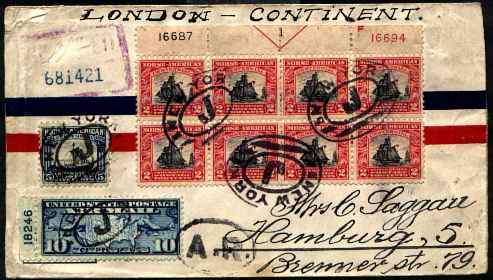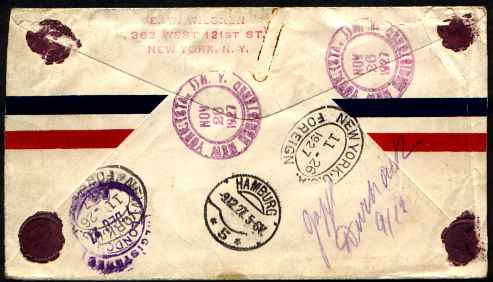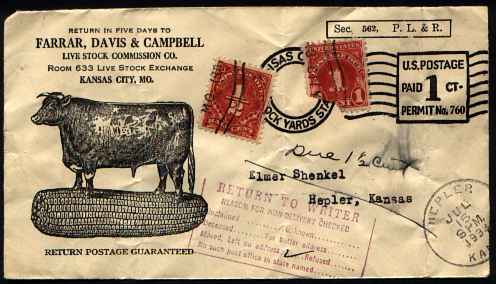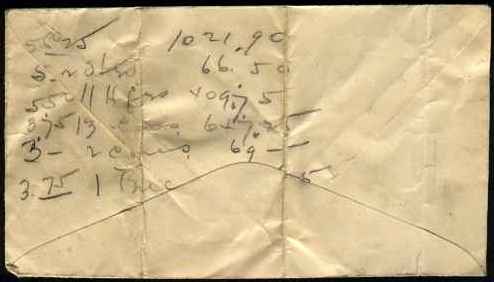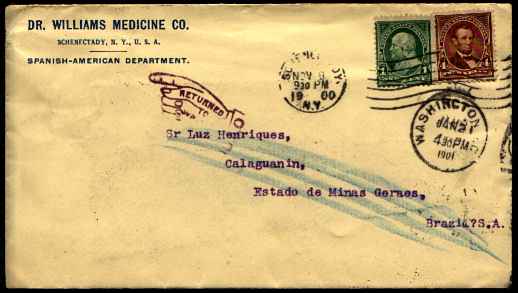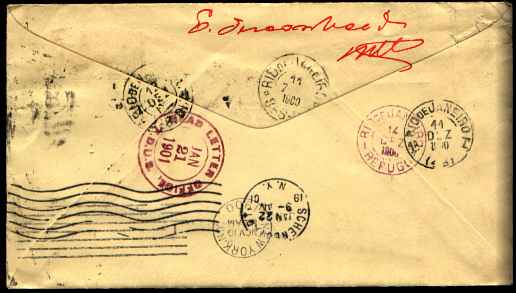

H is for Handstamp - Page 3 |

|

|

|

|
Just a Nice Cover
The year is 1927. No story here, just a nice cover, with a full plate block of eight of the 2c Norse-American
stamp, a single of the 5c value, and a single of the 10c Map Air Mail, for a total of 31c
postage. There are no Due markings, so this must have prepaid the letter correctly,
which works out, since the Air Mail rate at the time was 10c per half ounce, Registration
was 15c, and the Air rate from London to Germany was 6c. There was not yet a trans-
Atlantic air mail service, of course. The letter would have gone by ship from New York
to London, but if one wanted air mail for any part of the route, it had to be paid for
the entire route. We know it was Air Mail two ways - the blue and red bands on the
envelope, and the Air Mail stamp, both of which were reserved for Air Mail. The letter
was posted on Nov 26, received in London on December 7 and in Hamburg on December 12.
Twelve days seems reasonable for the trans-Atlantic ship crossing, but five is high for
London to Hamburg - perhaps the letter went by surface mail on the Continent for some
reason.
Any experts out there care to offer an explanation?
Differing Opinions
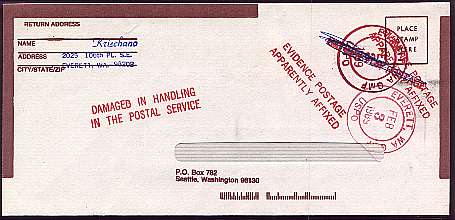
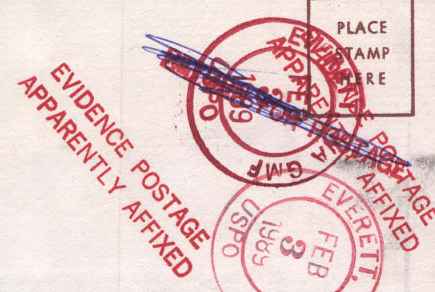
I like this cover for its conflicting opinions. A postal clerk initially stamped the
cover "RETURN FOR POSTAGE" - difficult to read beneath the ball-point strikeout. Someone
else overrode that opinion, and added the TWO strikes of "EVIDENCE POSTAGE APPARENTLY
AFFIXED" (the "APPARENTLY" is redundant, isn't it?), plus the "DAMAGED IN HANDLING IN THE
POSTAL SERVICE", a polite admission of responsibility for whatever mishap had occurred.
Received Without Contents
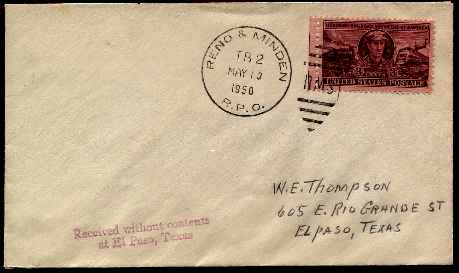

Postal regulations require that this handstamp be added to any envelope found to be
empty, even if it appears the absence of any enclosure was intentional. In this case, I
know that the sender was actually collecting RPO postmarks, because I have several such covers, identical
except for the postmarks. The moral is that unless you are collecting this handstamp,
put at least a blank piece of paper in any envelope you mail (though as automated as
things are these days I doubt it matters).
Investigation In Progress
Were it not so wrinkled, smudged, and generally abused, this would be a very collectible Advertising Cover. I bought it for its Postage Due stamps and handstamps. The use of Postage Due stamps was discontinued a couple of decades ago, indeed few people even know they ever existed, so I like interesting examples of their use. In this case, since the envelope apparently contained advertising initially, and was mailed in a bulk mailing and using a permit cancellation, we would ordinarily have no idea of its date. BUT thanks to that "RETURN POSTAGE GUARANTEED" we have a nice datestamp - July 15, 1934.
Using "The Beecher Book", I deduce that this was mailed using the "Third-Class, Regular, Bulk/Quantity-Discount" 1¢ per piece minimum rate in effect from 10/1/32 through 2/24/49 (Sec. 562 PL&R). That explains the "PAID 1 CT" in the permit imprint. My interpretation of the fee for returning the item is that it was charged as if forwarded, at a fee equal to the single-piece rate for this type of mail. The rate for Third-Class, Single-Piece from 4/15/25 through 1/1/49 was 1-1/2¢, which fits fine.
You may wonder why the sender would pay for the return of the item. What they actually
wanted was a forwarding address, which would have been sent instead of returning the
item, if it had been known. And as for the scribblings on the back, no philatelic
value there, just some on-the-fly bookkeeping.
"He who is his own doctor has a fool for a patient!"
Here's a favorite of mine - Scott 279 and 280 on cover to Brazil, November 9, 1900, with
various transit markings, including pointing hand ("RETURNED TO WRITER") and
DLO (Dead Letter Office) cds (circular date stamp). Minas Gerais (current
spelling) is the large inland state directly north of Rio de Janeiro. Calaguanin is not
shown on the current maps I had available (and in an Internet search using Google just
now, the only reference it returned was this page!).
Translation of enclosed letter (in Spanish, not Portuguese):
Dear Sir:
In other words, "We do not practice medicine by mail. See a doctor!"
In reply to your very esteemed medical inquiry dated October 10, we regret to inform you
that your illness does not lend itself to treatment through the mail, and consequently we
suggest that you consult a good physician in that area, and submit to his treatment.
(Apparently the addressee had expired by the time the letter reached him, as it was
returned.)
Actually, considering that this letter was pre-Food&Drug Law in this country
(1906),
perhaps it's surprising they refused to send the drugs.
---------------------- ANALYSIS and QUESTIONS --------------------------
Five cents was the UPU Surface Letter rate for letters up to 15 grams (about 1/2 ounce)
from 7/1/1875 to 10/1/1907.
Postal markings:
1. (front) 11/09/1900, Schenectady, NY
2. (back) 11/10/1900, New York, NY (steamship?)
3. (back) 12/11/1900, Rio de Janeiro (received?)
4. (back) ?/11/1900, Rio de Janeiro (??)
5. (back) 12/12/1900, Rio de Janeiro (returned?)
6. (back) 12/14/1900, Rio de Janeiro (purple - "REFUGO" = DLO?)
7. (front) 01/21/1901, Washington, DC
8. (back) 01/21/1901, Dead Letter Office (purple - "FDUS" = Foreign Dept
U S)
9. (front) (01/21/1901), Pointing Hand, "RETURNED TO WRITER"
(purple, same ink as DLO mark)
10. (back) 01/22/1901, Schenectady, NY (received)
---------------------------------------------------------------------------
Questions:
1. What is the red inscription on back? Since the letter seems almost a form letter,
unlikely this was added at time of mailing, so it must be an artifact of the cover?s
travels. Appears to be a signed notation of some sort - "Deceased"? Or
perhaps a note added at time of final receipt back at Dr. Williams?? (The Portuguese
word for deceased is "defuntos". In Spanish, it's "difunto".)
2. What do the various parts of the postal marks applied in Rio mean, e.g. "REFUGO"?
(Babel Fish translates "refugo" from Portuguese to English as "rubbish"!)
3. Why did this go to DLO? Any PO could have determined that it should be returned to
writer. (Based on the fact that I have several similar covers, it appears this was
standard procedure for international returned mail.)
STEAMBOAT

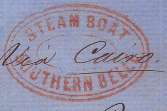

Steamboats were used to carry mail within the US during a relatively short period, and
letters received handstamps like these only when actually posted on the boat, so earlier
ones like those above are scarce and can command a high price. The one below (Towle O-21-
b) is later, dated April, 1874 (docketing on reverse), and more common - it would sell
for about $50. It was postmarked by a Route Agent on the Cincinnati-Louisville steamboat
on the Ohio River.
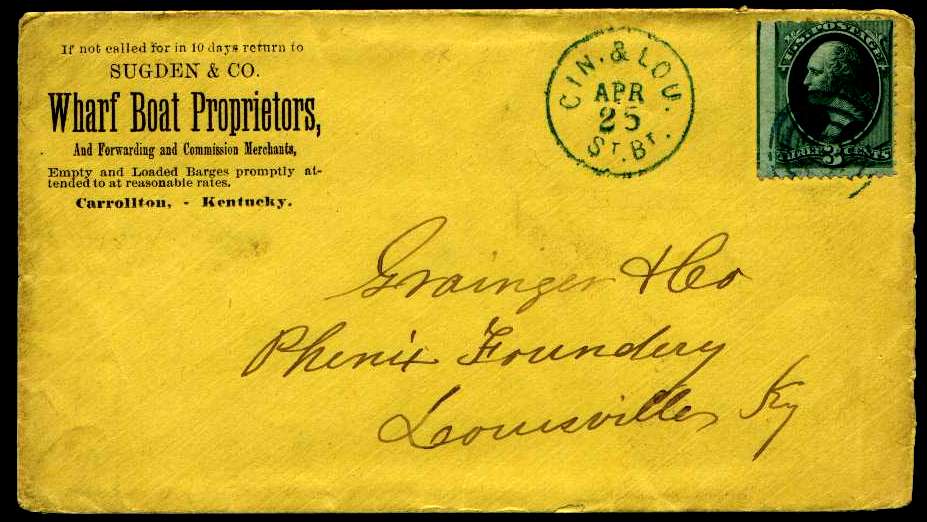
| Home | H - Page 2 <<< | Contents | >>> I is for Invert Error | Credits |
All Letter images Copyright © 1997, 2000, SF chapter of AIGA
All text Copyright © 2000, William M. Senkus
Send feedback to the webmaster: CLICK HERE
Revised -- 06/28/2004
